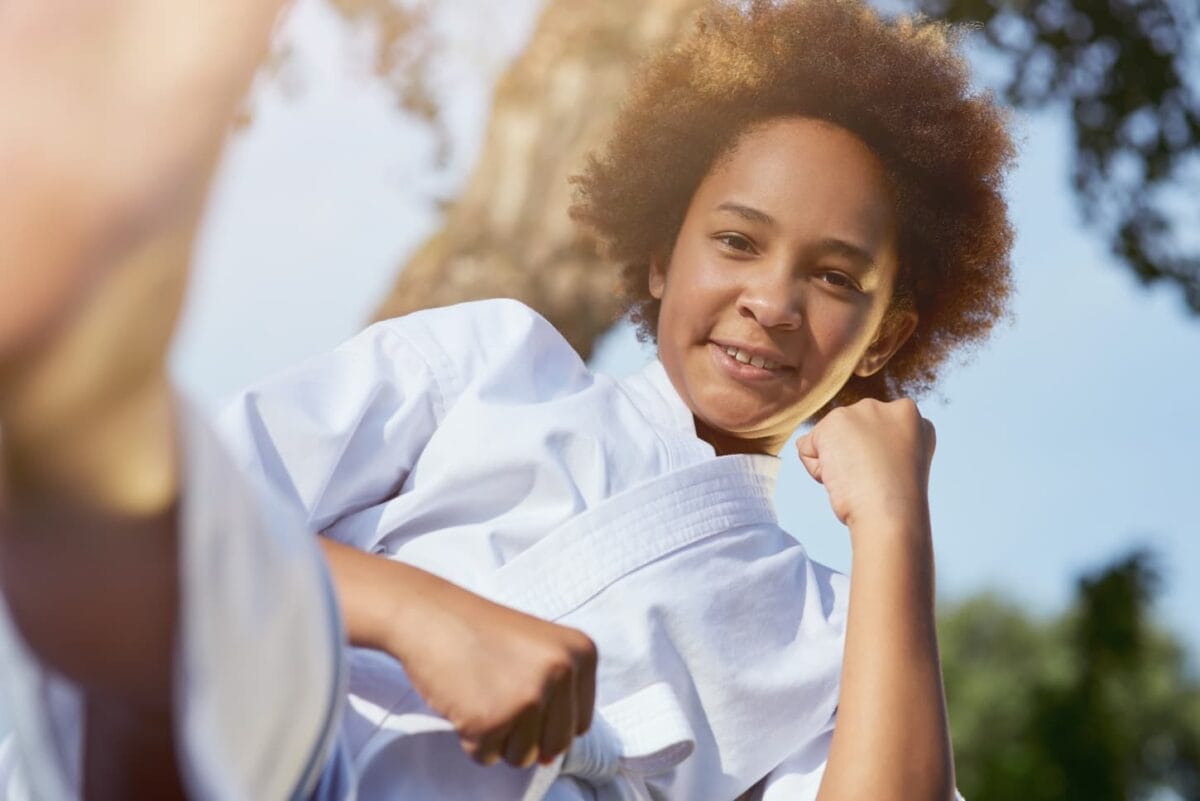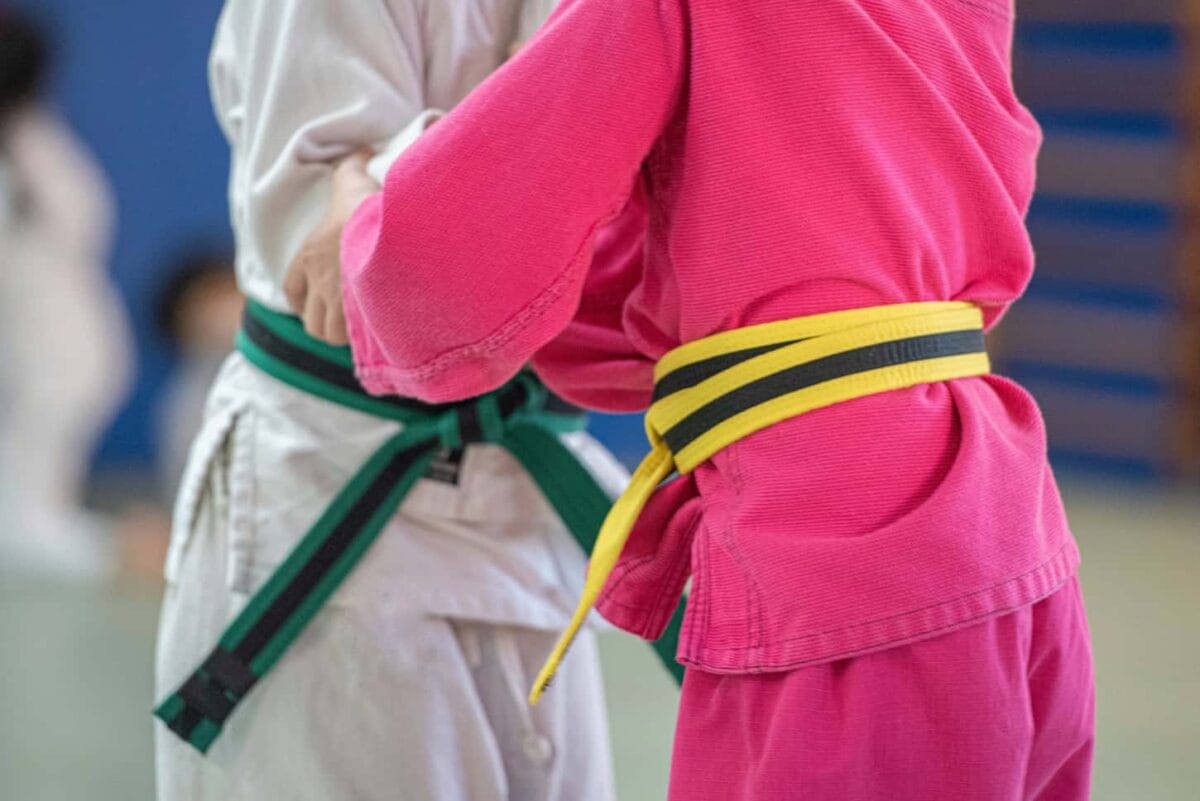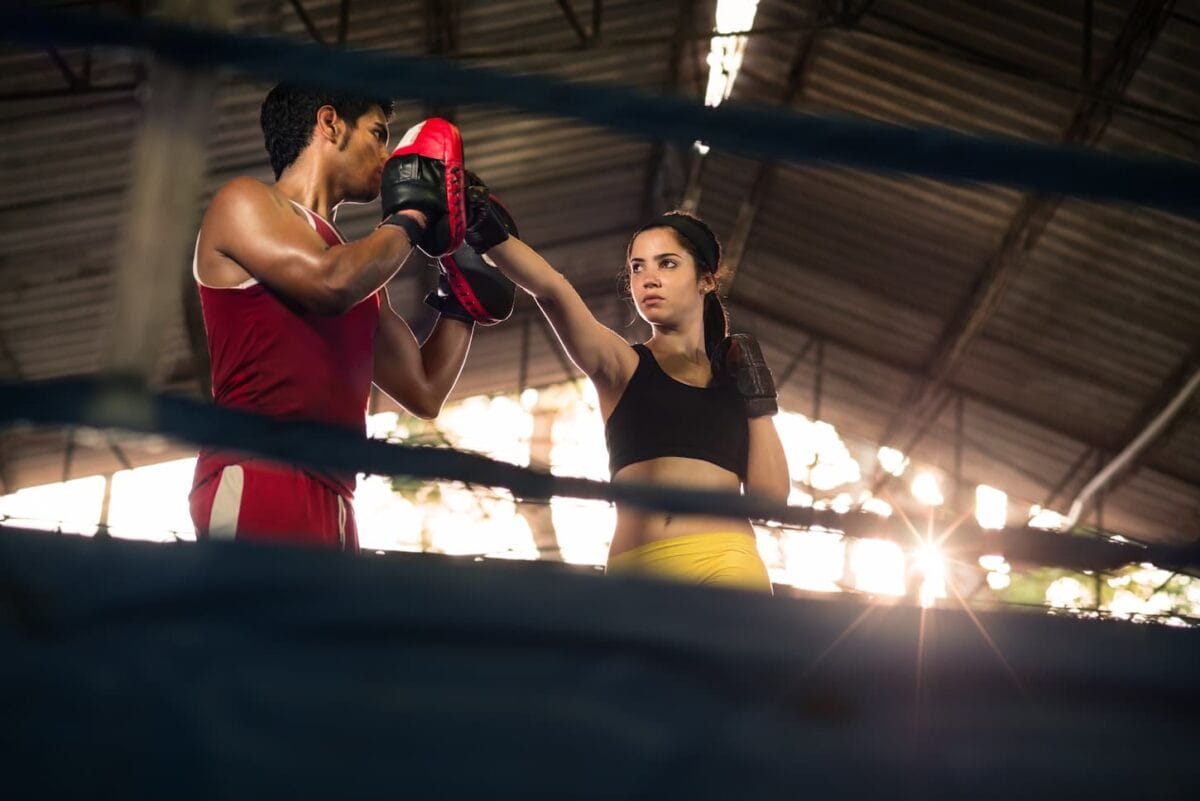Martial arts are a fantastic way for teenagers to keep fit and healthy and are much more than just a sport. They also teach children self-discipline, self-control, and how to defend themselves. There are many martial arts to choose from, and you might wonder which is best for your teenage daughter.
The best martial art for a teenage girl depends on her personality, interests, and expectations. Taekwondo provides an intense, full-body workout, while karate and kung fu focus on spirituality and self-discipline. The gentlest martial arts are Judo or Brazilian Jiu-Jitsu.
Teenage girls are undoubtedly more vulnerable to attacks, and learning a martial art can help them in dangerous situations. If you want your daughter to be fit, strong, disciplined, and able to defend themselves against an attack, we’ll discover the best martial art for a teenage girl below.

What is the Best Martial Art for a Teenage Girl?
The best martial art for teenage girls is one they are drawn to because each has its own philosophies, techniques, and training methods. To choose the right one, learn a bit about each to find a match for a daughter’s personality and expectations.
Martial arts are fantastic for teens not interested in traditional sports such as soccer or basketball, but there are over one hundred to choose from. To help parents make the correct choice, we’ve listed five of the most common ones below.
Brazilian Jiu Jitsu
Brazilian Jiu-Jitsu (BJJ) is a modern variation of traditional Japanese Jiu-Jitsu. It was developed in the early 1900s and is young compared to other martial arts. Brazilian Jiu-Jitsu is similar to Judo – it helps participants use their opponents’ strength against them and defend against larger attackers.
Judo and Brazilian Ju Jitsu are very similar – they are gentle martial arts that don’t include striking – instead, they use grappling, throws, and submissions. The main difference is that Brazilian Jiu-Jitsu allows choke holds and joint locks and is less formal than Judo.
In Brazilian Jiu-Jitsu, most of the combat is on the floor, making it better for self-defense because most attacks end on the ground. It’s also called human chess because participants must use problem-solving skills to overpower their opponent.
Taekwondo
Taekwondo is a dynamic, fast-paced martial art from Korea over 5,000 years old. It has deep traditions and involves breathing exercises, meditation, and gymnastic sequences to train the body and mind.
Taekwondo uses punching and kicking to fight opponents, with a strong focus on kicking, including spin and head kicks. It’s one of the best martial arts for building strength, flexibility, and balance but one of the least effective in self-defense.
With a 5,000-year history, Taekwondo is rich in culture and traditions, and participants work their way up the ranks with a colored belt system. It’s a disciplined art with a high moral code to promote a peaceful mind and a spiritual way of life.
Judo
Judo is a Japanese martial art derived from Jiu Jitsu and is one of the most popular martial arts in the USA. Judo translates as “the gentle way” and doesn’t use striking – instead, it focuses on grappling, throws, takedowns, and pinning to overcome opponents.
With Judo, the aim is to use the opponent’s strength against them to unbalance and overcome them. The result is that smaller participants can easily challenge larger, stronger ones. Judo is one of the safer martial arts but is still very physically and mentally challenging.
Girls who practice Judo have many opportunities to compete and will progress with learning through a belt system. Judo is very traditional and formal, with a strong focus on respect and self-discipline.
Karate
Karate is a popular martial art from Japan and translates as “empty-hand fighting.” It focuses on traditions and spiritual development and uses punches, kicking, and blocking for self-defense.
Karate is a very disciplined martial art based on developing patience, self-awareness, and self-control, and participants progress with a belt system. It encourages participants to become their best version and live respectfully.
There are non-contact versions of karate, which are safer, but they aren’t suitable for self-defense.
Some people wonder if martial arts and karate are the same things. Here is an explanation of that in this article: Are Martial Arts and Karate the Same Thing?
Kung Fu
Kung Fu comes from China and is among the oldest and most popular martial arts. It’s vigorous and fast-paced, so it is a fantastic way to burn energy but also focuses on calmness and patience.
Kung Fu is more fluid than other martial arts and involves quick strikes, pivots, long-range kicks, and punches. It’s very aerobic and is one of the best ways to build stamina and flexibility.
Kung Fu has a strong focus on self-discipline. It takes continuous work and dedication to master the art.
Pros and Cons of Learning Martial Arts for Teenage Girls
Practicing martial arts has many benefits for teenage girls. It gives them a workout and boosts their mental health and well-being. It also gives them self-defense skills and is a fantastic way to make new friends. The downside is that there is a risk of injury.
If parents want a better idea about the pros and cons of martial arts for teenage girls, look at the list below.

Pro: Martial arts are fantastic for physical health
Martial arts are fantastic for physical health because they are cardiovascular and provide a full-body workout. They also help teenage girls improve their strength, flexibility, stamina, and coordination.
Practicing martial arts burns many calories and is fantastic for weight loss. It also improves posture and improves reflexes.
Pro: It’s good for their mental health
Martial arts are fantastic for mental health because physical activity is one of the best stress relievers. Teenagers are less prone to anxiety and depression when they have a physical outlet.
Martial arts classes are a fantastic way to make friends and be a part of a community which is also beneficial for a teenager’s well-being. Most martial arts also incorporate mindfulness which helps teenagers stay grounded in the present.
Pro: Martial arts teach self-defense
Martial arts are based on self-defense, so girls who practice them are better prepared to deal with an attacker.
Not only can they physically defend themselves, but they will also remain calm if they are under attack. This gives them an advantage over the attacker, who expects a shocked, frozen, frightened victim.
Pro: It boosts confidence
Girls will make friends and become part of a community when they practice martial arts, which will improve their social skills and boost their confidence. Martial arts also promote self-awareness and can help teenage girls feel more comfortable about themselves.
Many martial arts are based on a tier system, usually with belts, and when teenagers accomplish goals and improve their rank, they have a huge sense of achievement. They will also get a confidence boost when they take part in tournaments and competitions.
Teenage girls need self-confidence, which can come from martial arts. It will help them immensely as an adult.
Pro: Martial arts teaches respect and self-discipline
Respect and self-discipline are at the core of most martial arts, and teenagers who practice them will learn a lot about the values of hard work and dedication.
Martial arts encourage teenagers to respect themselves, their body, and their environment, often leading to a healthier lifestyle. Martial arts also expose teenagers to different cultures and belief systems, so they develop respect for people from different walks of life.

Con: There is a risk of injury
Like with any sport, there is always a risk of injury with martial arts, and the most common ones are sprains, bruises, cuts, and scratches.
Choose a certified instructor and ensure the child practices in a safe environment with safety equipment to reduce the chance of injury. Make sure they drink plenty of water, warm up, and wind down before and after the session.
Con: People worry martial arts can cause aggression
It’s rare for martial arts to cause aggression – they focus on self-control and can help with aggressive behavior. In some cases, however, teenagers can be carried away by their new self-confidence and become aggressive.
If parents think their daughter won’t be responsible with her new skills, martial arts may not be a good idea. If she has a history of aggression or mental health condition, talk to your doctor and the instructor before enrolling them in classes.
Your healthcare team may recommend starting with therapy as a better bet in those cases. Once therapy starts, exercise (and martial arts) could become a viable option as a healthy outlet.
Is it Ever Too Late to Start Learning Martial Arts?
It is never too late to start learning martial arts. Some of the world’s most successful MMA fighters, such as Israel Adesanya, did not start until their late teens. It is good to start martial arts early, but people can pick it up at any age.
Teenage girls experience many physical and emotional changes, and practicing martial arts will help them stay balanced. That said, some teenagers might be reluctant to start new classes if they are self-conscious, so in this respect, it’s better if they start early.
It is never too late, and here is an article we wrote about thirteen-year-olds beginning martial arts to prove it.
What is the Best Self-Defense to Learn for a Teenage Girl?
The best martial arts for self-defense are Krav Marga and Muay Thai, two of the most aggressive martial arts. Teenage girls can also take part in RAD classes to learn about self-defense.
Martial arts will definitely help girls defend themselves, but they are taught in a controlled, sporting environment. The result is that girls may be at a loss in a real-life situation where they encounter an attacker with a knife on the street.
Krav Maga, Muay Thai, and RAD training focus on debilitating an attacker, and we’ll look at them below.
Krav Maga
Krav Maga is one of the most aggressive and violent martial arts, where the only rule is survival. It comes from Israel, where it was developed for the military and combined with many martial arts.
Krav Maga works with natural instincts and reactions and is easy to learn. It doesn’t follow traditional practices – it focuses on defending and counter-striking against any sized opponent.
Krav Maga incorporates punches, kicks, grappling, and striking with the knees and elbows. Many people find it extreme because it encourages head buts, groin, head and throat strikes, and even eye gouging.
If parents want their teenage girls to learn Krav Maga, they should choose a certified trainer.
Muay Thai
Muay Thai is also known as Thai kickboxing – it’s fast-paced and aggressive, making it popular in MMA. It’s called the art of eight limbs because it uses feet, elbows, hands, and knees for fighting and defense.
Thai boxing incorporates powerful, striking moves and combinations to take down an attacker quickly and is effective against multiple attackers. It’s easy to learn and works well in real-life situations.
RAD classes
Rape Aggression Defense (RAD) classes aren’t martial arts. They are taught by certified RAD instructors, usually the local police. In RAD class, teenage girls learn to avoid and prevent attacks and defend themselves against assailants.
Girls learn kicking, punching, and pressure point defense techniques using a manual, workbook, and practical exercise. They also know how to escape wrist grips, bear hugs, and choke holds.
RAD instructors create real-life scenarios and wear lots of padding and safety equipment so girls can practice the techniques with their full strength.
Some universities offer RAD classes as part of their PE curriculum; that’s where I learned about RAD classes. I took one semester of it, and it became one of my favorite classes while at college!

Which is Better for a Teenage Girl: Martial Arts or a R.A.D. Class?
RAD class is better for learning practical self-defense skills but does not come with the same benefits as practicing martial arts. RAD class is usually a one-off event or several classes, while martial arts take dedication and practice over years. Teenage girls can do both for the best results.
Not all martial arts are good for self-defense, so if we want our daughters to have practical defense skills, we should enroll them in a RAD class. If we want her to exercise regularly and learn about self-discipline, dedication, and basic self-defense, we should encourage martial arts.
Is it possible to learn martial arts at home? Read this article to learn: Can You Learn Martial Arts at Home? (4 Simple Ways).
Key Takeaways and Next Steps
To find the best martial art for a teenage girl, talk to them to discover their preferences. Each martial art is different; parents should learn a little about them before choosing one. The most common martial arts in the USA include Judo, Karate, Taekwondo, Brazilian jiu-jitsu, and Kung Fu.
Parents who want a teenage girl to practice martial arts for self-defense should choose aggressive ones such as Muay Thai or Krav Maga or enroll them in a RAD class. To ensure safety, always choose a certified instructor with a good reputation.
From here, we’ve got some more martial arts articles that you’ll want to check out:
- Do You Have To Wear A Gi (Uniform) To Martial Arts?
- Taekwondo vs Karate for Teens: What’s the Difference?
They’re both great resources, so be sure to check both out!
Resources
Learning from your own experiences is important, but learning from others is also smart. These are the sources used in this article and our research to be more informed as a family of sports nuts wannabes.
- Admin, A. (2019, September 2). Top 12 Health Benefits of Martial Arts. Karate America. https://www.karateamerica.info/top-12-health-benefits-of-martial-arts/
- Admin, W. (2016, May 21). The 6 Best Forms of Martial Arts for Women. W for Woman. https://wforwoman.com/content/the-6-best-forms-of-martial-arts-for-women
- Burdick, D. (1999, May 4). Judo | Definition, History, & Facts. Encyclopedia Britannica. https://www.britannica.com/sports/judo
- Campbell, J. (2022, September 25). What is the Best Martial Art for Teenage Girls? | Dojo Life HQ. Dojo Life HQ. https://dojolifehq.com/best-martial-art-for-teenage-girls/
- Cascio, R., & Cascio, R. (2021, December 31). What is Krav Maga. Krav Maga Worldwide | We Improve and Save Lives. https://www.kravmaga.com/what-is-krav-maga/
- Godman, H. (2014, April 9). Regular exercise changes the brain to improve memory, thinking skills. Harvard Health. https://www.health.harvard.edu/blog/regular-exercise-changes-brain-improve-memory-thinking-skills-201404097110
- Harwood, A., Lavidor, M., & Rassovsky, Y. (2017a). Reducing aggression with martial arts: A meta-analysis of child and youth studies. Aggression and Violent Behavior, 34, 96–101. https://doi.org/10.1016/j.avb.2017.03.001
- Harwood, A., Lavidor, M., & Rassovsky, Y. (2017b). Reducing aggression with martial arts: A meta-analysis of child and youth studies. Aggression and Violent Behavior, 34, 96–101. https://doi.org/10.1016/j.avb.2017.03.001
- Kim, H. J., Stebbins, C. L., Chai, J. H., & Song, J. S. (2011). Taekwondo training and fitness in female adolescents. Journal of Sports Sciences, 29(2), 133–138. https://doi.org/10.1080/02640414.2010.525519
- Kung Fu Training – Benefits of learning Chinese Martial Arts. (n.d.). Shaolin Warrior Martial Arts. https://shaolinwarriormartialarts.com/kung-fu-training-benefits/
- Lcsw, A. M. (2022, February 15). The Benefits and Risks of Martial Arts Classes for Teens. Verywell Family. https://www.verywellfamily.com/risks-and-benefits-of-martial-arts-for-teens-4118105
- R.A.D. Programs – Basic Physical Defense. (n.d.). http://www.rad-systems.com/rad_basic.html
- The Editors of Encyclopaedia Britannica. (1998, July 20). Jujitsu | martial art. Encyclopedia Britannica. https://www.britannica.com/sports/jujitsu
- What is the most useful martial art for self-defence for a teenage girl? (n.d.). Quora. https://www.quora.com/What-is-the-most-useful-martial-art-for-self-defence-for-a-teenage-girl
